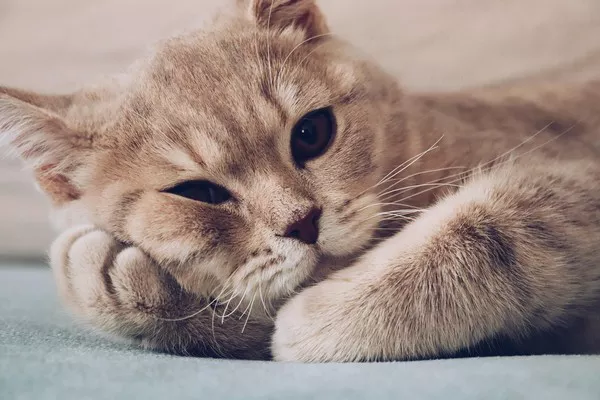What does a 2 Week Old Kitten look like? While that question might seem unrelated to kittens, it underscores the importance of understanding the unique characteristics of different animals. In this comprehensive guide, we’ll shift our focus to the tiny world of 2-week-old kittens. These delicate creatures are in a crucial stage of development, and recognizing their distinctive features is essential for proper care and nurturing.
How Can You Tell if a Kitten is 2 Weeks Old?
Determining a kitten‘s age is a skill every feline enthusiast should possess. At two weeks old, kittens undergo specific changes that set them apart from their younger and older counterparts. One key indicator is their eyes. Typically, 2-week-old kittens start to open their eyes, revealing tiny slivers of the world around them. The process of eye opening usually begins around the 10th day of life, but individual variations may occur. Observing this milestone can help accurately pinpoint a kitten’s age.
The Ear Transition:
A fascinating aspect of a 2-week-old kitten’s development is the evolution of their ears. At birth, their ears are typically folded and closely pressed to their heads. By the end of the second week, these tiny appendages start to unfold, giving the kitten a more alert and curious appearance. While they may not have the signature upright stance just yet, this subtle change signals the beginning of their journey towards becoming fully expressive, active felines.
The Wobbly Walk:
At two weeks old, kittens are still in the early stages of motor skill development. Their attempts to stand and move are adorable, characterized by a wobbly and unsteady gait. During this phase, you’ll witness the kittens attempting to explore their surroundings, often with clumsy yet endearing movements. Their playfulness becomes more apparent, as they engage in gentle interactions with their littermates, testing their newfound coordination.
Feeding and Growth:
At two weeks old, kittens are still entirely dependent on their mother’s milk. Nursing is a crucial aspect of their development, providing essential nutrients for growth and overall health. Observing the kittens during feeding sessions can offer valuable insights into their well-being. A healthy 2-week-old kitten will have a plump and round belly after nursing, indicating successful nourishment.
See Also:Nurturing Your 2-Week-Old Kitten: 6 Feeding Tips
The Teething Phase:
Teething begins around the second week of a kitten’s life, marking another milestone in their development. You may notice the kittens engaging in gentle nibbling behaviors, exploring the world through their mouths. While their tiny teeth are just starting to emerge, it’s essential to be mindful of their delicate gums. Providing appropriate teething toys can help satisfy their natural instincts and alleviate any discomfort associated with the teething process.
Socialization with Littermates:
The second week of a kitten’s life is marked by increased socialization with littermates. Playful interactions become more evident as the kittens start to explore the concept of play and engage in gentle wrestling matches. These interactions contribute to the development of important social skills, shaping their ability to communicate and bond with other cats later in life.
Sleep Patterns:
Understanding the sleep patterns of 2-week-old kittens is crucial for their overall well-being. While they are becoming more active during brief waking periods, the majority of their time is still spent sleeping. Ensuring a warm and comfortable environment is essential for their development, as they continue to rely on sleep to recharge their tiny bodies.
What Should 2-Week-Old Kittens Look Like?
As kittens progress through their second week of life, noticeable changes become evident in their physical appearance. Their fur, initially soft and delicate, begins to develop a slightly denser texture. While their coat color remains relatively consistent with that of their birth, any distinctive patterns may become more pronounced. A close examination during this stage can provide valuable insights into the kitten’s potential adult coat coloration and markings.
Can You Touch Kittens at 2 Weeks Old?
Handling newborn kittens requires utmost care, and the same holds true for 2-week-old kittens. While their eyes are now open, their fragility remains, and it’s essential to approach them with gentleness and caution. Gradual socialization through gentle touches is encouraged to foster a positive relationship between the kittens and humans. Ensuring a calm environment during these interactions is crucial to prevent unnecessary stress for the kittens.
Monitoring Health and Seeking Veterinary Care:
Regular health monitoring is vital during a kitten’s second week of life. Any signs of lethargy, lack of appetite, or unusual behavior should be promptly addressed by a veterinarian. As their immune systems continue to develop, kittens are susceptible to infections, making timely veterinary care crucial for their well-being. A veterinarian can also provide guidance on vaccinations and other preventive measures to ensure the kittens grow into healthy adults.
Conclusion:
In the intricate world of 2-week-old kittens, each day brings new developments and milestones. From the unfolding of their ears to the tentative steps in their wobbly walk, understanding the characteristics of these tiny creatures is key to providing the care and support they need. By observing their unique features, practicing gentle handling, and ensuring a nurturing environment, you contribute to the healthy growth and development of these adorable feline companions.
Related Topics:
Understanding Your 2-Week-Old Kitten’s Poop
What to Expect When Caring for a 2-Week-Old Kitten
Feeding a 2-Week-Old Kitten: Tips and Tricks
























